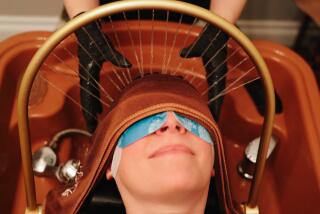Top Secret : ‘Hair-Replacement Units,’ the Toupees of the ‘80s, Are Comfortable, Undetectable--and Nobody’s Idea of a Joke
- Share via
For every Bruce Willis who wears his receding hairline proudly, there seems to be a Burt Reynolds who prefers to go under cover.
Balding men can spend a great deal of time, money and emotion pursuing solutions. Some have invested as much as $20,000 for hair-transplant surgery, which--if not performed properly--can be painful and may not produce natural-looking results. Others await Food and Drug Administration approval of Minoxidil, Upjohn’s so-called wonder-drug hair restorer. However, according to Dr. David Whiting, clinical associate professor of dermatology at Southwestern Medical School in Dallas, Minoxidil has been found to be effective in fewer than one out of three cases. And, he adds, in instances in which the drug does prompt new growth, it is sometimes only fuzz.
So, many men are concluding that one of the oldest solutions to hair loss--the hairpiece-- is still one of the most effective. Toupees, or “hair-replacement units” as they are now called, have been the butt of jokes for generations. But Edward Katz, president of Edward Katz International Hair Design in Los Angeles, says, “If a unit is designed correctly and maintained properly, it not only is undetectable but is perfectly compatible with the client’s life style.”
Katz, who readily admits that his own thick, wavy, dark hair comes off for maintenance now and then, says he swims, plays tennis, sails and sleeps with it on.
Custom units are expensive--$600 to $2,400, says Michael Mahoney, president of the Texas-based American Hair Loss Council--and they require cleaning and servicing every three to four weeks, usually at a cost of $50 to $60 per treatment. He adds that because a unit’s life expectancy is nine to 12 months, its annual price tag can easily exceed $3,000. But, he says, it is a worthwhile expense.
If a man’s first hairpiece is an inexpensive, off-the-shelf model, it may sour him on the idea altogether, Mahoney says. In contrast, “a custom hairpiece is molded to the specific head, rather than to a standard size. It’s blended to exactly match the individual’s hair color and density,” so there is a greater likelihood that the man will like what he sees when he looks in the mirror.
Dr. Toby G. Mayer, co-chairman of the Division of Facial Plastic and Reconstructive Surgery at the University of Southern California, agrees that custom service is a must. “A man should choose a hair specialist with the same care that he would choose a surgeon,” he says.
Custom hairpieces are made from either fine human hair or synthetic material. Many men prefer the feel of human hair, but it oxidizes when exposed to sunlight or water and may become discolored. And although synthetic hair is less likely to discolor, it usually doesn’t hold a style as long as human hair does.
There are other choices to make regarding application and type of hairpiece. Mayer says that hairpieces should never be surgically attached to the scalp. “Anything foreign eventually erodes and causes scarring and infection,” he says.
Weaves that braid or clip the hairpiece to the hair do not pose that problem, Mayer says. But as the natural hair grows, the weave loosens and has to be reattached every three to four weeks. He cautions that if the weave puts too much tension on the hair, the natural hair can fall out. If the tension continues, hair loss can be permanent.
Glue or double-sided adhesive tapes usually will not cause hair loss, but they require shaving whatever hair is under the hairpiece. The bonding is secure, so many men are tempted to leave the units on for prolonged periods. That is dangerous, Mahoney says, because it prevents the scalp from breathing and can cause clogged pores and cysts. Ideally, he says, most pieces should be removed and the scalp cleansed every week.
Practical considerations may be easier to deal with than the long-term psychological implications, says Los Angeles-based psychotherapist Ashely Siegel, who specializes in emotional problems stemming from hair loss.
“We live in a physically oriented culture,” Siegel says. “The hair-replacement unit provides an option. But covering up can lead to a fear of exposure and can cause the person with the hairpiece to push others away to avoid the possibility of exposure,” she says.
Still, for many people, a hair- replacement unit is simply another way to improve the appearance, the way a good haircut does. As Mahoney says, “the only reason hairpieces have gotten a bad rap is that people only notice the bad ones. They don’t see the good ones.”
More to Read
Sign up for Essential California
The most important California stories and recommendations in your inbox every morning.
You may occasionally receive promotional content from the Los Angeles Times.













